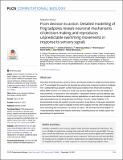Files in this item
From decision to action : detailed modelling of frog tadpoles reveals neuronal mechanisms of decision-making and reproduces unpredictable swimming movements in response to sensory signals
Item metadata
| dc.contributor.author | Ferrario, Andrea | |
| dc.contributor.author | Palyanov, Andrey | |
| dc.contributor.author | Koutsikou, Stella | |
| dc.contributor.author | Li, Wenchang | |
| dc.contributor.author | Soffe, Steve | |
| dc.contributor.author | Roberts, Alan | |
| dc.contributor.author | Borisyuk, Roman | |
| dc.date.accessioned | 2022-01-10T17:30:03Z | |
| dc.date.available | 2022-01-10T17:30:03Z | |
| dc.date.issued | 2021-12-13 | |
| dc.identifier | 277084242 | |
| dc.identifier | 86db1c58-b087-4fc7-bf2f-19b93390d31f | |
| dc.identifier | 34898604 | |
| dc.identifier | 85122305027 | |
| dc.identifier | 000891413900001 | |
| dc.identifier.citation | Ferrario , A , Palyanov , A , Koutsikou , S , Li , W , Soffe , S , Roberts , A & Borisyuk , R 2021 , ' From decision to action : detailed modelling of frog tadpoles reveals neuronal mechanisms of decision-making and reproduces unpredictable swimming movements in response to sensory signals ' , PLoS Computational Biology , vol. 17 , no. 12 , e1009654 . https://doi.org/10.1371/journal.pcbi.1009654 | en |
| dc.identifier.issn | 1553-734X | |
| dc.identifier.other | ORCID: /0000-0002-1179-6636/work/105006981 | |
| dc.identifier.uri | https://hdl.handle.net/10023/24634 | |
| dc.description | Funding: A.F. acknowledges support from the UK Engineering and Physical Sciences Research Council (EPSRC) New Investigator Award (EP/R03124X/1). The work of A.P. was performed according to the Russian Federation Government research assignment for A.P. Ershov Institute of Informatics Systems SB RAS, project FWNU-2021-0005. S.K. acknowledges support from The Physiological Society UK Research Grant award. R.B. acknowledges support from the UK Biotechnology and Biological Sciences Research Council (BBSRC): BB/L000814/1, BB/T002352/1. W.L. acknowledges support from the UK Biotechnology and Biological Sciences Research Council (BBSRC): BB/T003146. | en |
| dc.description.abstract | How does the brain process sensory stimuli, and decide whether to initiate locomotor behaviour? To investigate this question we develop two whole body computer models of a tadpole. The “Central Nervous System” (CNS) model uses evidence from whole-cell recording to define 2300 neurons in 12 classes to study how sensory signals from the skin initiate and stop swimming. In response to skin stimulation, it generates realistic sensory pathway spiking and shows how hindbrain sensory memory populations on each side can compete to initiate reticulospinal neuron firing and start swimming. The 3-D “Virtual Tadpole” (VT) biomechanical model with realistic muscle innervation, body flexion, body-water interaction, and movement is then used to evaluate if motor nerve outputs from the CNS model can produce swimming-like movements in a volume of “water”. We find that the whole tadpole VT model generates reliable and realistic swimming. Combining these two models opens new perspectives for experiments. | |
| dc.format.extent | 41 | |
| dc.format.extent | 6095724 | |
| dc.language.iso | eng | |
| dc.relation.ispartof | PLoS Computational Biology | en |
| dc.subject | QH301 Biology | en |
| dc.subject | QA76 Computer software | en |
| dc.subject | RC0321 Neuroscience. Biological psychiatry. Neuropsychiatry | en |
| dc.subject | DAS | en |
| dc.subject | MCC | en |
| dc.subject.lcc | QH301 | en |
| dc.subject.lcc | QA76 | en |
| dc.subject.lcc | RC0321 | en |
| dc.title | From decision to action : detailed modelling of frog tadpoles reveals neuronal mechanisms of decision-making and reproduces unpredictable swimming movements in response to sensory signals | en |
| dc.type | Journal article | en |
| dc.contributor.institution | University of St Andrews. School of Psychology and Neuroscience | en |
| dc.contributor.institution | University of St Andrews. St Andrews Isotope Geochemistry | en |
| dc.contributor.institution | University of St Andrews. Institute of Behavioural and Neural Sciences | en |
| dc.identifier.doi | 10.1371/journal.pcbi.1009654 | |
| dc.description.status | Peer reviewed | en |
This item appears in the following Collection(s)
Items in the St Andrews Research Repository are protected by copyright, with all rights reserved, unless otherwise indicated.

